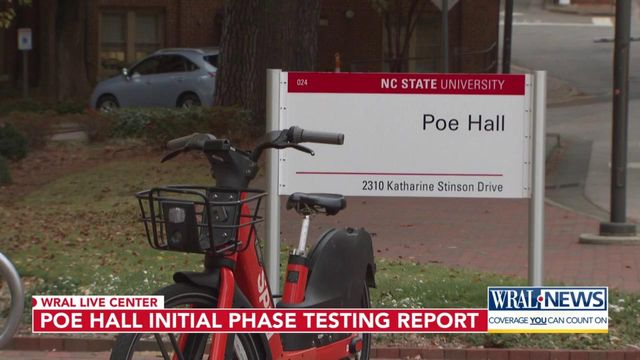NC State releases initial PCB test results from Poe Hall, more work to be done to determine extent of exposure for students and staff
North Carolina State University on Thursday released the first report of polychlorinated biphenyl (PCB) test results from Poe Hall.
The university contracted Geosyntec Consultants to do an environmental assessment in the building, home to the College of Education and Psychology Department, after preliminary testing in November revealed high levels of PCBs, toxic chemicals linked to cancer.
The report released Thursday is the first after more extensive testing, but it is not yet a complete picture.
Geosyntec Consultants took 14 air samples and 67 surface samples, searching for PCBs inside Poe Hall. The report says only one sample showed PCB levels above EPA limits.
However, experts highlighted to 5 On Your Side that the sampling was done with the HVAC system off and is not reflective of the scenario in which people were exposed to possible contaminants in Poe Hall.
"I have major problems with the method of analysis," said Dr. David Carpenter, a professor at the State University of New York at Albany whose work focuses on the study of environmental causes of human disease.
Carpenter analyzed the report and said that the fact that Poe Hall's HVAC system has been off since November distorts the view of what's going on.
"The fact that the HVAC system was off and the sampling was done and they still found elevations in samples in air and in swipe samples suggests to me that that sampling analysis underestimates significantly the real exposure people had," Carpenter said.
He also noted that the testing only looked for nine types of Aroclors – a common trade name of certain PCB mixtures – instead of the full spectrum of more than 200 PCBs.
"That analysis is not accurate to adequately measure PCBs in the air," Carpenter said.
The Geosyntec report noted in the sampling methodology that EPA methods were followed during testing.
The report theorizes PCBs are distributed through Poe Hall through the HVAC system, and Carpenter says once the system is turned back on and tested that should provide a better insight into what the people who spent time inside Poe Hall were exposed to.
The Geosyntec report says this is a phased investigation and testing with the HVAC system off was the first phase. It’s not clear when we will get results of testing with the HVAC system on, but the report says that is part of the next steps.
In the months since the building was closed, more than 100 people who worked or were students at Poe Hall, have told 5 On Your Side they were diagnosed with some form of cancer.
Here are some of the highlights from the report on the first round of testing:
- 14 indoor air samples did detect the PCB known as Aroclor-1262, but the university said all levels were below EPA exposure levels for PCBs in schools. It is important to remember that the HVAC system has been off since November 2023 and remained off throughout the testing. This means no dust particles of any kind were circulating through the air handler system.
- 67 surface, or swipe, samples were taken throughout all seven of Poe Hall’s floors. Samples were taken from desktops, books, bathroom counters, air supply vents and several other locations. 25 wipe samples detected Aroclor-1262, but the report says only one was above EPA threshold.
According to NC State’s overview of the report, both air and surface samples were low overall. However, the highest readings from preliminary testing in October and November came from “bulk” tests. Bulk test results are not included in Geosyntec’s first report.
According to the EPA, bulk solid sampling typically includes removing a small portion of the potentially contaminated material for analytical testing. For example, a caulk sample would be the quantity of caulk needed by the laboratory for analytical testing, removed directly from the suspect area.
Testing in October showed bulk samples taken in the fifth floor women’s bathroom were 38 times EPA limits, and other bulk samples tested high for PCBs. Recommendations in the new report from Geosyntec indicate bulk samples of potential sources will be collected and analyzed, notably focused on the HVAC system.
Geosyntec recommends turning on the HVAC system to do more air and surface wipe sampling after bulk samples are analyzed.
The final recommendation in the report is to review studies on PCBs to understand the potential human health effects associated with exposure.













